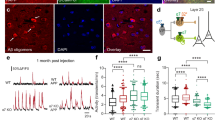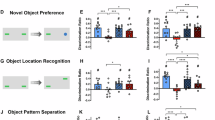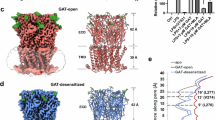Abstract
Galantamine, a drug for Alzheimer’s disease, is a novel cholinergic agent with a dual mode of action, which inhibits acetylcholinesterase and allosterically modulates nicotinic acetylcholine receptors (nAChRs), as a result stimulates catecholamine neurotransmission. In the present study, we investigated whether galantamine exerts cognitive improving effects through the allosteric modulation of nAChR in the intracerebroventricular beta amyloid (Aβ)25−35-injected animal model of Alzheimer’s disease. Galantamine (3 mg/kg p.o.) significantly increased the extracellular dopamine release in the hippocampus of saline- and Aβ25−35-injected mice. The effects of nicotine on the extracellular dopamine release were potentiated by galantamine, but antagonized by mecamylamine, a nAChR antagonist. Aβ25−35-injected mice, compared with saline-injected mice, could not discriminate between new and familiar objects in the novel object recognition test and exhibited less freezing response in the fear-conditioning tasks, suggesting Aβ25−35 induced cognitive impairment. Galantamine improved the Aβ25−35-induced cognitive impairment in the novel object recognition and fear-conditioning tasks. These improving effects of galantamine were blocked by the treatment with mecamylamine, SCH-23390, a dopamine-D1 receptor antagonist, and sulpiride, a dopamine-D2 receptor antagonist, but not by scopolamine, a muscarinic acetylcholine receptor antagonist. This study provides the first in vivo evidence that galantamine augments dopaminergic neurotransmission within the hippocampus through the allosteric potentiation of nAChRs. The improving-effects of galantamine on the Aβ25−35-induced cognitive impairment may be mediated through the activation of, at least in part, dopaminergic systems, and the enhancement of dopamine release may be one of multiple mechanisms underlying the therapeutic benefit of galantamine.
Similar content being viewed by others
Log in or create a free account to read this content
Gain free access to this article, as well as selected content from this journal and more on nature.com
or
References
Assal F, Cummings JL (2002). Neuropsychiatric symptoms in the dementias. Curr Opin Neurol 15: 445–450.
Burghaus L, Schutz U (2000). Quantitative assessment of nicotinic acetylcholine receptor proteins in the cerebral cortex of Alzheimer patients. Brain Res Mol Brain Res 76: 385–388.
Daumas S, Halley H, Lassalle JM (2004). Disruption of hippocampal CA3 network: effects on episodic-like memory processing in C57BL/6J mice. Eur J Neurosci 20: 597–600.
Eisele JL, Bertrand S, Galzi JL, Devillers-Thiery A, Changeux JP, Bertrand D (1993). Chimaeric nicotinic-serotoninergic receptor combines distinct ligand binding and channel specificities. Nature (Lond) 366: 479–483.
Enomoto T, Noda Y, Mouri A, Shin EJ, Wang D, Murai R et al (2005). Long-lasting impairment of associative learning is correlated with a dysfunction of N-methyl-D-aspartate-extracellular signaling-regulated kinase signaling in mice after withdrawal from repeated administration of phencyclidine. Mol Pharmacol 68: 1765–1774.
Erkinjuntti T (2002). Treatment options: the latest evidence with galantamine (Reminyl). J Neurol Sci 203–204: 125–130.
Geerts H (2005). Indicators of neuroprotection with galantamine. Brain Res Bull 64: 519–524.
Geerts H, Guillaumat PO, Grantham C, Bode W, Anciaux K, Sachak S (2005). Brain levels and acetylcholinesterase inhibition with galantamine and donepezil in rats, mice and rabbits. Brain Res 1033: 186–193.
Guan ZZ, Miao H, Tian JY, Unger C, Nordberg A, Zhang X (2001). Suppressed expression of nicotinic acetylcholine receptors by nanomolar beta-amyloid peptides in PC12 cells. J Neural Transm 10: 1417–1433.
Guan ZZ, Yu WF, Shan KR, Nordman T, Olsson J, Nordberg A (2003). Loss of nicotinic receptors induced by beta-amyloid peptides in PC12 cells: possible mechanism involving lipid peroxidation. J Neurosci Res 71: 397–406.
Hammond RS, Tull LE, Stackman RW (2004). On the delay-dependent involvement of the hippocampus in object recognition memory. Neurobiol Learn Mem 82: 26–34.
Harkany T, O’Mahony S, Kelly JP, Soos K, Toro I, Penke B et al (1998). Beta-amyloid(Phe(SO3H)24)25–35 in rat nucleus basalis induces behavioral dysfunctions, impairs learning and memory and disrupts cortical cholinergic innervation. Behav Brain Res 90: 133–145.
Hefco V, Yamada K, Hefco A, Hritcu L, Tiron A, Nabeshima T (2004). The interaction between the cholinergic and dopaminergic system in learning and memory process in rats. Rom J Physiol 41: 21–30.
Itoh A, Nitta A, Nadai M, Nishimura K, Hirose M, Hasegawa T et al (1996). Dysfunction of cholinergic and dopaminergic neuronal systems in β-amyloid protein—infused rats. J Neurochem 66: 1113–1117.
Kamei H, Nagai T, Nakano H, Togan Y, Takayanagi M, Takahashi K et al (2006). Repeated methamphetamine treatment impairs recognition memory through a failure of novelty-induced ERK 1/2 activation in the prefrontal cortex of mice. Biol Psychiatry 59: 75–84.
Kume T, Sugimoto M, Takada Y, Yamaguchi T, Yonezawa A, Katsuki H et al (2005). Up-regulation of nicotinic acetylcholine receptors by central-type acetylcholinesterase inhibitors in rat cortical neurons. Eur J Pharmacol 527: 77–85.
Levin ED, Simon BB (1998). Nicotinic acetylcholine involvement in cognitive function in animals. Psychopharmacology (Berl) 138: 217–230.
Lockhart BP, Benicourt C, Junien JL, Privat A (1994). Inhibitors of free radical formation fail to attenuate direct β-amyloid25–35 peptide-mediated neurotoxicity in rat hippocampal cultures. J Neurosci Res 39: 494–505.
Maelicke A, Albuquerque EX (2000). Allosteric modulation of nicotinic acetylcholine receptors as a treatment strategy for Alzheimer's disease. Eur J Pharmacol 393: 165–170.
Maelicke A, Schrattenholz A, Samochocki M, Radina M, Albuquerque EX (2000). Allosterically potentiating ligands of nicotinic receptors as a treatment strategy for Alzheimer's disease. Behav Brain Res 113: 199–206.
Maurice T, Lockhart BP, Privat A (1996). Amnesia induced in mice by centrally administered beta-amyloid peptides involves cholinergic dysfunction. Brain Res 706: 181–193.
Nagai T, Yamada K, Kim HC, Kim YS, Noda Y, Imura A et al (2003). Cognitive impairment in the genetic model of aging klotho gene mutant mice: a role of oxidative stress. FASEB J 17: 50–52.
Nordberg A (2001). Nicotinic receptor abnormalities of Alzheimer's disease: therapeutic implications. Biol Psychiatry 49: 200–210.
Palmer AM (2002). Pharmacotherapy for Alzheimer's disease: progress and prospects. Trends Pharmacol Sci 23: 426–433.
Paxinos G, Franklin KBJ (2004). The Mouse Brain in Stereotaxic Coordinates, Compact, 2nd edn. Elsevier Academic Press: San Diego, USA.
Rampon C, Tang YP, Goodhouse J, Shimizu E, Kyin M, Tsien JZ (2000). Enrichment induces structural changes and recovery from nonspatial memory deficits in CA1 NMDAR1-knockout mice. Nat Neurosci 3: 238–244.
Santos MD, Alkondon M, Aracava Y, Eisenberg HM, Maelicke A, Albuquerque EX (2002). The nicotinic allosteric potentiating ligand galantamine facilitates synaptic transmission in the mammalian central nervous system. Mol Pharmacol 61: 1222–1234.
Schroder H, Giacobini E, Struble RG, Zilles K, Maelicke A (1991). Nicotinic cholinoceptive neurons of the frontal cortex are reduced in Alzheimer’s disease. Neurobiol Aging 12: 259–262.
Sharp BM, Yatsula M, Fu Y (2004). Effects of galantamine, a nicotinic allosteric potentiating ligand, on nicotine-induced catecholamine release in hippocampus and nucleus accumbens of rats. J Pharmacol Exp Ther 309: 1116–1123.
Turner TJ (2004). Nicotine enhancement of dopamine release by a calcium-dependent increase in the size of the readily releasable pool of synaptic vesicles. J Neurosci 24: 11328–11336.
Van Dam D, De Deyn PP (2006). Cognitive evaluation of disease-modifying efficacy of galantamine and memantine in the APP23 model. Eur Neuropsychopharmacol 16: 59–69.
Wan Q, Luo ZP, Wang H (2003). Muscarinic receptor activities potentiated by desensitization of nicotinic receptors in rat superior cervical ganglia. Acta Pharmacol Sin 24: 657–662.
Woodruff-Pak DS, Santos IS (2000). Nicotinic modulation in an animal model of a form of associative learning impaired in Alzheimer's disease. Behav Brain Res 113: 11–19.
Woodruff-Pak DS, Vogel III RW, Wenk GL (2003). Mecamylamine interactions with galantamine and donepezil: effects on learning, acetylcholinesterase, and nicotinic acetylcholine receptors. Neuroscience 117: 439–447.
Acknowledgements
We are grateful to the Janssen Pharmaceutical KK for donating galantamine. This work was supported, in part, by Grants-in-Aid for Scientific Research from the Japan Society for the Promotion of Science (14370031) (15922139) (16922036) (17390018), for Scientific Research on Priority Areas on ‘Elucidation of glia-neuron network mediated information processing systems’ from Ministry of Education, Culture, Sports, Science and Technology (16047214), for Funds from Integrated Molecular Medicine for Neuronal and Neoplastic Disorders (21st Century COE program), for the Japan Brain Foundation, for the Mitsubishi Pharma Research Foundation and, for an SRF Grant for Biomedical Research.
Author information
Authors and Affiliations
Corresponding author
Rights and permissions
About this article
Cite this article
Wang, D., Noda, Y., Zhou, Y. et al. The Allosteric Potentiation of Nicotinic Acetylcholine Receptors by Galantamine Ameliorates the Cognitive Dysfunction in Beta Amyloid25–35 I.c.v.-Injected Mice: Involvement of Dopaminergic Systems. Neuropsychopharmacol 32, 1261–1271 (2007). https://doi.org/10.1038/sj.npp.1301256
Received:
Revised:
Accepted:
Published:
Issue date:
DOI: https://doi.org/10.1038/sj.npp.1301256
Keywords
This article is cited by
-
Galantamine ameliorates experimental pancreatitis
Molecular Medicine (2023)
-
The novel adamantane derivatives as potential mediators of inflammation and neural plasticity in diabetes mice with cognitive impairment
Scientific Reports (2022)
-
Harnessing plant biotechnology-based strategies for in vitro galanthamine (GAL) biosynthesis: a potent drug against Alzheimer’s disease
Plant Cell, Tissue and Organ Culture (PCTOC) (2022)
-
MMP9 modulation improves specific neurobehavioral deficits in a mouse model of Alzheimer’s disease
BMC Neuroscience (2021)
-
β-Amyloid and Lithium Affect the Magnitude of Phasic Dopamine Release in the Shell of the Nucleus Accumbens
Neuroscience and Behavioral Physiology (2021)



